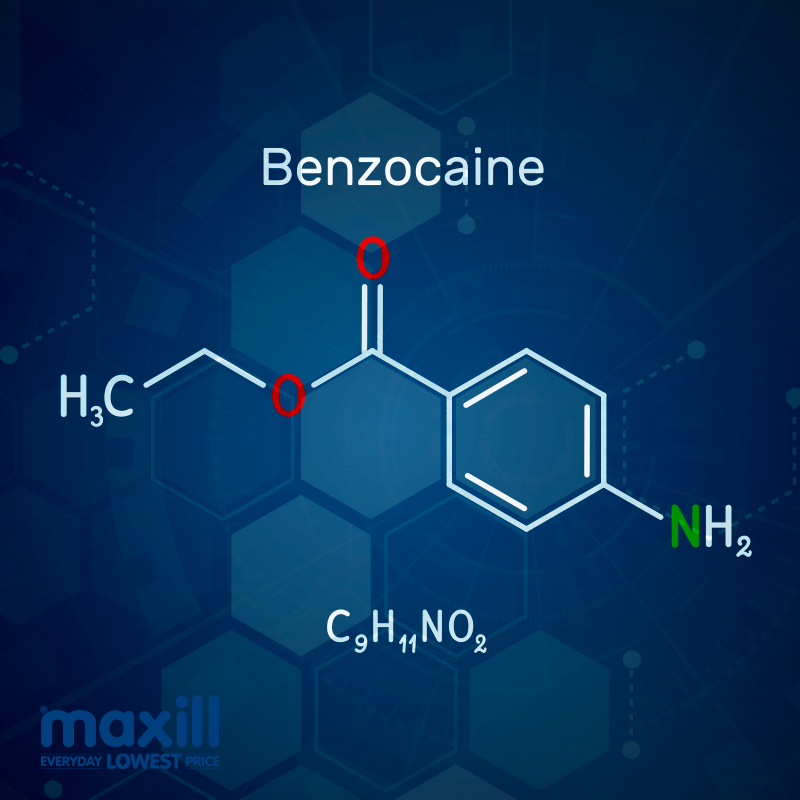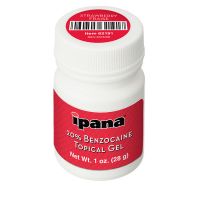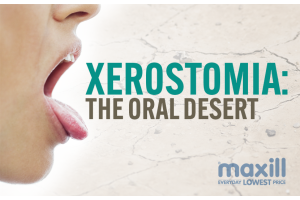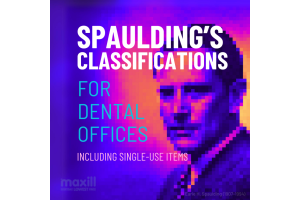Because You Asked | All About Benzocaine: An In-Depth Exploration

An In-Depth Exploration of Uses, Safety Measures, and Applications of Benzocaine
Benzocaine is a popular topical anesthetic that offers relief from things such as pain, itching, and discomfort in various situations. In this article, we'll delve into what benzocaine is, how to use it, where and how to apply benzocaine topicals, potential side effects, and the clinical applications in a dental office.
What is Benzocaine and How Do You Use It?
Benzocaine is a synthetic compound classified as a topical anesthetic. It works by temporarily numbing the area where it is applied, thanks to its ability to block nerve signals. Benzocaine is available in various forms, including creams, gels, sprays, ointments, and lozenges. The specific usage instructions may vary based on the product, but the general guidelines for use include:
Skin application: Clean and dry the affected area before applying a thin layer of the product. Avoid open wounds or broken skin.
Mucous membrane application: For toothaches or a sore throat, involves using a small amount of gel or a lozenge as directed on the product label.
Throat Sprays and Lozenges: Designed for sore throat relief, includes sprays that can be applied directly to the back of the throat, or a lozenge as directed on the product label.
It's crucial to follow package directions and consult a healthcare provider for personalized guidance, especially if you're using benzocaine for specific medical conditions.
In Dentistry: Dentists often use benzocaine as a topical localize anesthetic to numb the oral mucosa prior to an anesthetic injection. This is in preparation for a multitude of dental procedures. The benzocaine gel like the one available at maxill is applied to the anesthetic injection site mucosa prior to administering local anesthetic solutions. Dental hygienists may use a benzocaine spray on the gumline and surrounding tissues, to alleviate sensitivity or discomfort during dental cleanings.
Where Do You Apply Benzocaine Gel?
Benzocaine gel can be applied to the skin or mucous membranes. The location depends on the specific discomfort you're aiming to alleviate. For skin application, apply it to the affected area. For oral or mucous membrane discomfort, like a toothache or sensitivity, follow the instructions on the product label.
In Dentistry: Dentists typically apply a 20% Benzocaine topical gel directly to the mucosa (soft tissues). This allows the temporary numbing effect to alleviate discomfort from the anesthetic needle to ensure patients are comfortable during anesthetic injections. Topical benzocaine sprays can be used to temporarily numb areas of sensitivity or discomfort during dental cleanings, or in cases of severe gag reflex, topical sprays can be used to numb the oropharynx mucosa to get that perfect impression, or those pesky hard to capture x-rays.
How Long Do You Leave Benzocaine On?
The duration that you leave benzocaine on varies depending on the specific product and the instructions provided. Follow the recommended usage guidelines on the packaging to ensure safe and effective use.
In Dentistry: Benzocaine topical anesthetics have a rapid onset of less than 1 minute when applied to any oral mucosa, with an approximate duration of 5 to 10 minutes.
How Do You Use Benzocaine Oral Gel as a Home Remedy?
When using benzocaine oral gel for home remedies, ensure that you adhere to the product's usage directions. Generally, you'll apply a small amount of the gel to the affected area in your mouth, such as the sore spot from an appliance or canker sore, as directed on the packaging.
Are There Any Side Effects of Benzocaine?
While benzocaine is generally safe when used as directed, it can cause side effects in some individuals. Common side effects may include skin irritation, redness, itching, or a burning sensation at the application site. In rare cases, allergic reactions may occur, leading to more severe side effects. If you experience any unusual or severe reactions, discontinue use, and seek medical attention.
What Happens If You Use Too Much Benzocaine?
Using too much benzocaine or exceeding the recommended dosage can increase the risk of side effects, including the potential for more severe skin reactions or systemic effects. It is crucial to use benzocaine as directed to avoid overuse.
Can You Overdose on Benzocaine?
While benzocaine overdoses are rare, excessive use can lead to systemic effects, including dizziness, confusion, headache, irregular heartbeats, and, in extreme cases, methemoglobinemia, a condition that reduces the oxygen-carrying capacity of the blood. Always make sure to adhere to the recommended dosages and usage and seek medical attention if you suspect an overdose.
Why Can You Only Use Benzocaine 4 Times a Day?
For over-the-counter benzocaine products, the limitation of using benzocaine up to four times a day is a safety precaution. Using it excessively can lead to a higher risk of side effects and potential overdosage. Always follow the product's instructions and recommended dosages.
What Drugs Interact with Benzocaine?
Benzocaine may interact with certain medications or medical conditions. If you're taking other drugs or have specific medical concerns, consult a healthcare professional before using benzocaine products to avoid potential interactions.
What Products Have Benzocaine?
Benzocaine can be found in various over-the-counter products, including oral pain relief gels, cough drops, teething gels for babies, and topical creams or sprays for pain relief and itching. Always check the product label for the active ingredients, and directions for use.
How Long Does Benzocaine Oral Gel Last?
The duration of relief provided by over-the-counter benzocaine oral gel can vary from person to person and depends on the specific product and percentage of Benzocaine present. Generally, it offers temporary relief that lasts anywhere from 5-15 minutes at full affect. Some stronger formulations have an effect that continue, albeit at a diminished intensity, for several hours after application, providing ongoing relief. Most over the counter topical gels with Benzocaine can be applied multiple times per day. Make sure to always follow the product’s instructions for use.
What is Stronger: Benzocaine or Lidocaine?
Lidocaine is generally considered a more potent local anesthetic compared to benzocaine. However, the choice between the two depends on the specific use, case, and individual preferences. Lidocaine is often used for medical and dental procedures, while benzocaine, in addition to it's dental application is also found in over-the-counter products for general pain relief.
In Dentistry: Lidocaine is a common anesthetic solution administered via injection to induce localized anesthesia, effectively numbing patients for dental procedures. It serves to block nerve signals and ensures that the patient feels no pain during treatment, lasting for several hours after being administered.
However, benzocaine is typically formulated as a topical gel or spray specifically used to numb the mucosal area within the mouth where the lidocaine injection in intended. It provides temporary loss of sensation to the surface layers (2-3mm) of the soft tissues at the site of the injection, ensuring that the patient experiences minimal to no discomfort during the needle insertion. Essentially, benzocaine acts as a preliminary anesthetic agent applied topically before administering a more powerful anesthetic solution such as lidocaine, which work together to enhance patient comfort.
What Other Topical Anesthetics Do Dentists and Hygienists Use to Numb Your Mouth?
In dentistry, various topical anesthetics can be used to numb specific areas in the mouth during dental procedures. Apart from benzocaine, which is one of the most frequently used topical anesthetic agents in dentistry, they also utilize Cetacaine and topical lidocaine.
Cetacaine: Cetacaine is a unique combination of three topical anesthetics—benzocaine, butamben, and tetracaine. This triple-ester mixture offers both a rapid onset of action (15-30 seconds) and a long duration of up to 60 minutes. Dentists often use Cetacaine for subgingival applications during dental hygiene procedures. It can potentially replace injectable anesthetics in patients for whom injectable agents may be contraindicated. However, Cetacaine should be avoided in patients allergic to esters or para-aminobenzoic acid (PABA) and those at risk for methemoglobinemia.
Lidocaine: Although less common in dentistry compared to benzocaine, lidocaine can serve as an alternative topical anesthetic, especially for patients who should avoid esters. Professional use lidocaine topical anesthetic is typically available in a 5% ointment formulation. Dentists should be cautious about the risk of overdose with amide topical anesthetics like lidocaine, particularly when used in larger application areas and in combination with injectable versions of these agents. It is essential to adhere to recommended maximum doses and consider the cumulative dose from all lidocaine formulations when used concurrently.
Lidocaine + Prilocaine: A commonly employed dental topical analgesic, consisting of 25 mg/g of lidocaine and 25 mg/g of prilocaine, finds frequent use among dental hygienists. This combination proves beneficial when a gentler anesthetic is preferred over a local anesthetic. It becomes particularly useful in situations where a patient opts against an injectable anesthetic or when the need for analgesic effects is brief.
Dental hygienists apply the lidocaine and prilocaine combination during non-surgical periodontal therapy debridement and periodontal probing to enhance client comfort. The duration of its effects falls within an individual range of 14–31 minutes. This pharmaceutical form exists as a low-viscosity fluid at room temperature, transforming into an elastic gel when placed intraorally in the periodontal pockets using a designated applicator.
For some interesting trivia, this numbing combination extends its utility beyond dentistry. It is also employed in the service industry for permanent cosmetic applications, such as microblading of eyebrows and lip shadowing.
In summary, benzocaine is a versatile topical anesthetic that can provide effective relief when used as directed whether in a dental setting, or at home. Always follow the product's instructions, or consult a healthcare provider for personalized guidance, and be mindful of potential side effects and interactions to ensure safe and effective use.
References:
- Donaldson D, Gelskey SC, Landry RG, Matthews DC, Sandhu HS. A placebo-controlled multi-centred evaluation of an anaesthetic gel (Oraqix) for periodontal therapy. J Clin Periodontol 2003;30(3):171–5.
- U.S. Food and Drug Administration. "Safety Information: Benzocaine-Containing Products." Accessed November 9, 2023. https://www.fda.gov/drugs/postmarket-drug-safety-information-patients-and-providers/safety-information-benzocaine-containing-products
- Health Canada. "Oral Healthcare Products." Government of Canada, 9 Nov. 2023. https://webprod.hc-sc.gc.ca/nhpid-bdipsn/atReq.do?atid=oral.hcp&lang=eng








